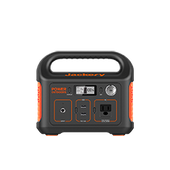What Is A 1500W Generator?
A 1500-watt generator is a small-sized generator capable of producing 1500 watts of power to charge sensitive and small to medium devices such as phones, laptops, cameras, microwaves, kettles, etc. Whether you are out on a camping trip, need backup power for an emergency, or are on RV trips, the 1500-watt generator can supply power covering various scenarios. However, knowing what appliances you should run before investing in a 1500-watt generator is essential to check if the generator can provide enough power.
There are three different types of generators you must be aware of:
1500-Watt Portable Generator: As the name suggests, 1500-watt portable generators are small, lightweight, and feature a compact and sturdy design. They can be carried along while traveling or at a campsite and fit easily in vehicles without occupying much space. These generators can provide energy safely and conveniently while charging your appliances in case there is a power cut or you need power during travel adventures.
1500-Watt Inverter Generator: Inverter generators are less noisy and more efficient than traditional gas, electric, and diesel generators. A 1500-watt inverter generator can provide a clean and safer power supply for various small and medium-sized devices such as portable air conditioners, electric drills, and pressure cookers.
1500-Watt Solar Generator: Solar generators are sustainable next-generation generators that use renewable and clean solar energy to power electronic devices. These are modern, innovative alternatives to gas and diesel generators. 1500-watt solar generators function quietly, are fumes-free, and can charge various appliances for multiple purposes. Jackery Solar Generators are available in different capacities to meet your charging requirements.
Starting Wattage: Starting wattage is the wattage required to start the device and create momentum so that it starts running. The combined starting wattage of all the devices you charge is essential before deciding upon the generator. Starting wattage is also denoted as peak or surge wattage.
Running Wattage: Running watts or rated watts is the continuous electricity your device needs. It is essential to keep the device running, and the generator must be able to handle the running wattage of the devices to prevent the appliance's momentum from falling.
Surge Wattage: A surge is the peak amount of power specific devices need for a few hours to start. Rated and surge wattages are two wattages that must be calculated before choosing a generator for your power needs.
Watt-hours: Watt-hours is the amount of energy an appliance consumes over time. Generators with high watt-hours usually ensure the efficiency and smooth performance of appliances.
What Can a 1500-Watt Generator Run?
A 1500-watt generator can run a specific range of small and medium devices required for emergencies, such as RV, work site, and home emergencies. They can also provide a certain degree of power during off-grid and power devices such as mobile phones, laptops, power banks, microwaves, induction cookers, etc. While considering what a 1500-watt generator can power, it is essential to check the rate and surge wattage. The section below describes what a 1500-watt generator can charge at home, at a construction site, and in an RV.
Will a 1500-watt Generator Run A House?
Yes, a 1500-watt generator can run some household devices such as electric drills, microwaves, communication devices, cameras, CPAP machines, computers, etc. However, heavy-duty devices won’t get charged with a 1500-watt generator.
What Can a 1500-watt generator run on construction sites?
Magnetic drilling machines, hand-held drills, corner drills, t-handle drills, sanders, etc., are some electric tools that can be charged using a 1500-watt generator in construction sites. However, if you are looking forward to charging multiple tools simultaneously, you should remain limited to the generator's surge power.

What can a 1500-watt generator run in an RV?
A 1500-watt generator would be one of many power requirements for your RV, but it can charge various devices if you live in a van. It can charge a mini fridge, LED lights, ice maker, projector, power bank, phone, etc.

Jackery 1500W Portable Generators
Jackery Solar Generators are solar power systems suitable for next-generation generators. They depend on green and clean solar energy to supply power to charge your devices. The solar generators are much lighter than conventional generators and feature a compact and sturdy design. They combine Jackery SolarSaga Solar Panels and Jackery Portable Power Station to charge your devices for indoor and outdoor purposes.
Jackery Solar Generator 1500
The Jackery Solar Generator 1500 is a high-capacity generator that provides green, quiet, and convenient energy solutions. It is ideal for camping and can charge laptops, cameras, electric grills, kettles, coffee makers, and more. It has fast solar charging, is lightweight and compact, and has an ergonomic folding handle that makes it easy to transport anywhere.

Jackery Solar Generator 1000 Plus
The Jackery Solar Generator 1000 Plus can support 99% of devices and has an expandable capacity. It can support three battery packs and ensures one to three days of backup power for camping, off-road travel, home emergencies, and more. It is shock-resistant and fire-retardant and operates at a noise level of less than 30dB.

Jackery Solar Generator 1000 v2
The Jackery Solar Generator 1000 v2 features a bifacial solar panel, which is up to 10% more efficient and saves charging time. It can power essentials such as coffee makers, heater throws, projectors, cameras, drones, etc. In various scenarios, such as off-road travel, RV living, or power outages, the solar generator can charge multiple devices at the same time.

|
Product |
Output Rated/Surge |
Capacity |
Appliances Running Time |
|
Jackery Solar Generator 1500 |
1800W/3600W |
1,534Wh(60.9Ah/25.2V) |
Microwave (700W): 1.8H Kettle (850W): 1.5H Electric Drill (800W): 1.6H |
|
Jackery Solar Generator 1000 Plus |
2000W /4000W |
1264Wh(30.4Ah/41.6V) |
Car Fridge (60W): 18.0H Electric Cooker (900W): 1.1H Television (70W): 15.3H |
|
Jackery Solar Generator 1000 v2 |
1500W/3000W |
1070Wh (30.4Ah/35.2V) |
Coffee Maker (550W): 1.6H Heated Throw (230W): 3.9H Projector (100W): 9.0H |
What Size Generator Do I Need?
To know what size of generator you need to power your devices, here is a step-by-step process you need to follow to calculate the length of the generator to power appliances:
Step 1: In the first step, note all the devices you need to charge simultaneously and their running and starting wattage. If you cannot find the device’s wattage, you can use this formula:
Step 2: In the next step, you can add the running wattage of all the devices on your list. Once you add the running wattage, find the device with the highest starting wattage.
Step 3: Lastly, add the total running wattage with the highest starting wattage; the total number will represent the surge wattage applied by the generator.

How Many Amps Does A 1500-Watt Generator Produce
You can use a mathematical formula given below to calculate how many amps a 1500-watt generator will produce
Amps (I) = Watts (W) ÷ Volts (V)
So, here if we consider 1500W and 120V, the amps will be:
I = 1500W ÷ 120V = 12.5A
If the volts are 240V, the amps will be:
I = 1500W ÷ 240V = 6.25A
This concludes that a 9500-watt solar generator will produce 6.25 amps at 240 and 12.5 amps at 120 volts.
Let's consider another example :
The Jackery Explorer 1000 Plus Portable Power Station has a battery capacity of 1264Wh and is operated at 41.6V DC. Using the formula, the amp-hour will be:
Amp-hour (Ah) = Watt-hour (Wh) ÷ Volts (V) = 1264Wh ÷ 41.6V DC = 30.4Ah.
What Is The Price Of 1500 Watt Generator
The price range of portable generators in the US market ranges from $300 to $2000, whereas solar generators are priced anywhere between $1000 and $10000, depending upon the size and capacity of the product. Regarding cost-effectiveness, Jackery stands out as one of the most economical brands in the US market, offering products of similar sizes and capacities but at a much lower rate.
FAQ
What will a 1400-watt generator run a refrigerator and air conditioner?
A 1400-watt generator can run a refrigerator and a portable air conditioner consuming less than 1400 watts of electricity per hour.
What size generator is used to run a house with AC?
A 7000-8000-watt generator would be suitable for running a house with AC.
What are the cons of an inverter generator?
Inverter generators have higher costs and lower outputs than conventional generators. Moreover, using inverter generators indoors is unsafe as they use gasoline.
Conclusion
A 1500-watt generator can run small and medium-sized devices such as microwaves, laptops, projectors, kettles, coffee makers, computers, phones, and more. It suits home backup supplies, construction sites, and RV living. A generator should fulfill your power needs whenever and wherever you need it, and to choose the right capacity generator, it is essential to check the rated and surge wattage of the appliances.













































































































































Leave a comment